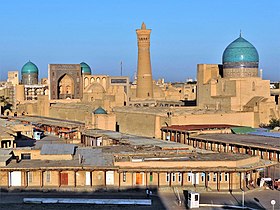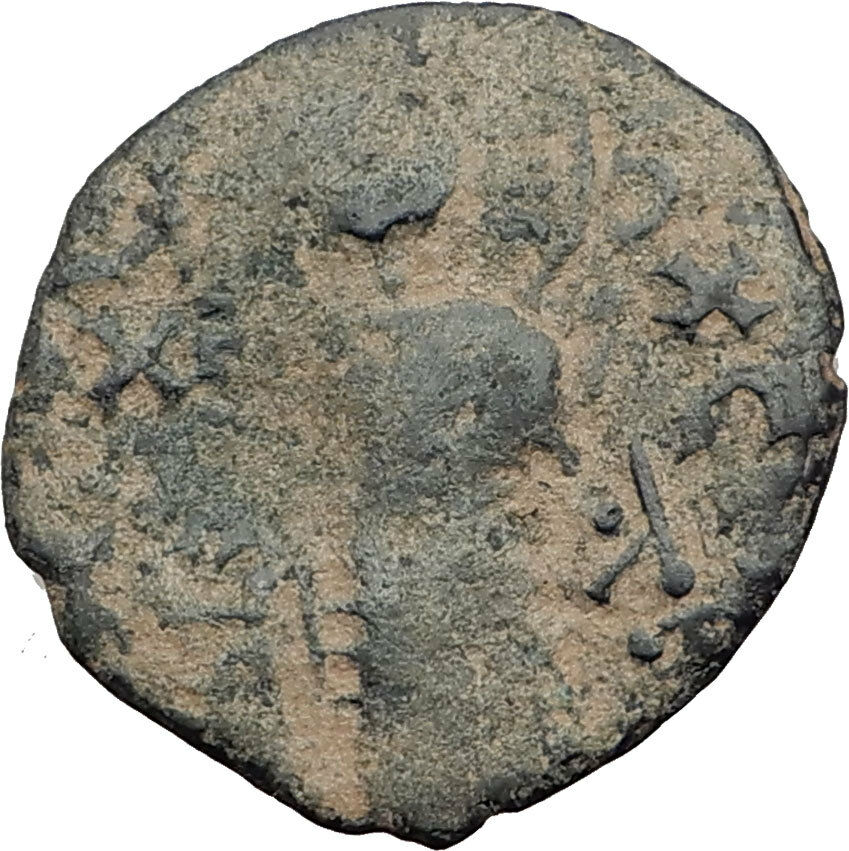|
ISLAMIC – Bukhara – Qarakhanid
Yusuf b Ali (AH 416-433)
Bronze Fals 28mm (2.87 grams) Struck 1031AD, 423AH
Reference: Koch A 3350
Ornate text.
Ornate text.
You are bidding on the exact item pictured, provided with a Certificate of Authenticity and Lifetime Guarantee of Authenticity.
.jpg/220px-Bringing_the_sheep_home,_on_the_southern_shore_of_Issyk-Kul_(3968109583).jpg) The Kara-Khanid Khanate (Persian: قراخانیان, romanized: Qarākhāniyān), also known as the Karakhanids, Qarakhanids, Ilek Khanids or the Afrasiabids (Persian: آل افراسیاب, romanized: Āl-i Afrāsiyāb, lit. ‘House of Afrasiab’), was a Turkic khanate that ruled Central Asia in the 9th through the early 13th century. The dynastic names of Karakhanids and Ilek Khanids refer to royal titles with Kara Kağan being the most important Turkic title up till the end of the dynasty. The Kara-Khanid Khanate (Persian: قراخانیان, romanized: Qarākhāniyān), also known as the Karakhanids, Qarakhanids, Ilek Khanids or the Afrasiabids (Persian: آل افراسیاب, romanized: Āl-i Afrāsiyāb, lit. ‘House of Afrasiab’), was a Turkic khanate that ruled Central Asia in the 9th through the early 13th century. The dynastic names of Karakhanids and Ilek Khanids refer to royal titles with Kara Kağan being the most important Turkic title up till the end of the dynasty.
The Khanate conquered Transoxania in Central Asia and ruled it between 999 “1211. Their arrival in Transoxania signaled a definitive shift from Iranian to Turkic predominance in Central Asia, yet the Kara-khanids gradually assimilated the Perso-Arab Muslim culture, while retaining some of their native Turkic culture.
The capitals of the Kara-Khanid Khanate included Kashgar, Balasagun, Uzgen and Samarkand. In the 1040s, the Khanate split into the Eastern and Western Khanates. In the late 11th century, they came under the suzerainty of the Seljuks, followed by the Kara-Khitans in the mid-12th century. The Eastern Khanate was ended by the Kara-Khitans in 1211. The Western Khanate was extinguished by the Khwarazmian dynasty in 1213.
The history of the Kara-Khanid Khanate is reconstructed from fragmentary and often contradictory written sources, as well as studies on their coinage.

Bukhara (Uzbek Latin: Buxoro; Uzbek Cyrillic: Бухорo; پارسی : بخارا) is a city in Uzbekistan. Bukhara is rich in historical sites, with about 140 architectural monuments. The nation’s fifth-largest city, it had a population of 247,644 as of 31 August 2016. People have inhabited the region around Bukhara for at least five millennia, and the city has existed for half that time. The mother tongue of the majority of people of Bukhara is Tajik. Located on the Silk Road, the city has long served as a center of trade, scholarship, culture, and religion. UNESCO has listed the historic center of Bukhara (which contains numerous mosques and madrasas) as a World Heritage Site.
Names
Bukhara was known as Bokhara in 19th- and early-20th-century English publications and as Buhe/Puhe(捕喝) in Tang Chinese.
According to the Encyclopædia Iranica the name Bukhara is possibly derived from the Sogdian βuxārak (“Place of Good Fortune”)
Muhammad ibn Jafar Narshakhi in his History of Bukhara (completed 943-44 CE) mentions:
Bukhara has many names. One of its name was Numijkat. It has also been called “Bumiskat”. It has 2 names in Arabic. One is “Madinat al Sufriya” meaning-“the copper city” and another is “Madinat Al Tujjar” meaning-“The city of Merchants”. But, the name Bukhara is more known than all the other names. In Khorasan, there is no other city with so many names.
Since the Middle Ages, the city has been known as Buḫārā / بخارا in Arabic and Persian sources. The modern Uzbek spelling is Buxoro.
The city’s name was mythologized as Albracca in the Italian epic poem Orlando Innamorato published in 1483 by Matteo Maria Boiardo.
History
The history of Bukhara stretches back millennia. It is now the capital of Bukhara Region (viloyat) of Uzbekistan. Located on the Silk Road, the city has long been a center of trade, scholarship, culture, and religion. During the golden age of the Samanids, Bukhara became a major intellectual center of the Islamic world, second only to Baghdad. The historic center of Bukhara, which contains numerous mosques and madrassas, has been listed by UNESCO as a World Heritage Site.
Bukhara has been one of the main centres of world civilisation from its early days in 6th century BCE. From the 6th century CE, Turkic speakers gradually moved in. Its architecture and archaeological sites form one of the pillars of Central Asian history and art. The region of Bukhara was a part of the Persian Empire for a long time. The origin of many of its current inhabitants goes back to the period of Aryan immigration into the region.
The Samanid Empire seized Bukhara, the capital of Greater Khorasan, in 903 CE. Genghis Khan besieged Bukhara for fifteen days in 1220 CE. As an important trading centre, Bukhara was home to a community of medieval Indian merchants from the city of Multan (modern-day Pakistan) who were noted to own land in the city.
Bukhara was the last capital of the Emirate of Bukhara and was besieged by the Red Army during the Russian Civil War. During the Bukhara operation of 1920, an army of well-disciplined and well equipped Red Army troops under the command of Bolshevik general Mikhail Frunze attacked the city of Bukhara. On 31 August 1920, the Emir Alim Khan fled to Dushanbe in Eastern Bukhara (later he escaped from Dushanbe to Kabul in Afghanistan). On 2 September 1920, after four days of fighting, the emir’s citadel (the Ark) was destroyed, the red flag was raised from the top of Kalyan Minaret. On 14 September 1920, the All-Bukharan Revolutionary Committee was set up, headed by A. Mukhitdinov. The government-the Council of People’s Nazirs (see nāẓir)-was presided over by Faizullah Khojaev.
The Bukharan People’s Soviet Republic existed from 1920 to 1925 when the city was integrated into the Uzbek Soviet Socialist Republic. Fitzroy Maclean, then a young diplomat in the British Embassy in Moscow, made a surreptitious visit to Bokhara in 1938, sight-seeing and sleeping in parks. In his memoir Eastern Approaches, he judged it an “enchanted city” with buildings that rivalled “the finest architecture of the Italian Renaissance”. In the latter half of the 20th century, the war in Afghanistan and civil war in Tajikistan brought Dari- and Tajik-speaking refugees into Bukhara and Samarkand. After integrating themselves into the local Tajik population, these cities face a movement for annexation into Tajikistan with which the cities have no common border.
|




.jpg/220px-Bringing_the_sheep_home,_on_the_southern_shore_of_Issyk-Kul_(3968109583).jpg) The Kara-Khanid Khanate (Persian: قراخانیان, romanized: Qarākhāniyān), also known as the Karakhanids, Qarakhanids, Ilek Khanids or the Afrasiabids (Persian: آل افراسیاب, romanized: Āl-i Afrāsiyāb, lit. ‘House of Afrasiab’), was a Turkic khanate that ruled Central Asia in the 9th through the early 13th century. The dynastic names of Karakhanids and Ilek Khanids refer to royal titles with Kara Kağan being the most important Turkic title up till the end of the dynasty.
The Kara-Khanid Khanate (Persian: قراخانیان, romanized: Qarākhāniyān), also known as the Karakhanids, Qarakhanids, Ilek Khanids or the Afrasiabids (Persian: آل افراسیاب, romanized: Āl-i Afrāsiyāb, lit. ‘House of Afrasiab’), was a Turkic khanate that ruled Central Asia in the 9th through the early 13th century. The dynastic names of Karakhanids and Ilek Khanids refer to royal titles with Kara Kağan being the most important Turkic title up till the end of the dynasty. 





